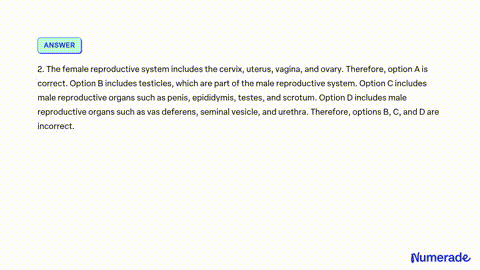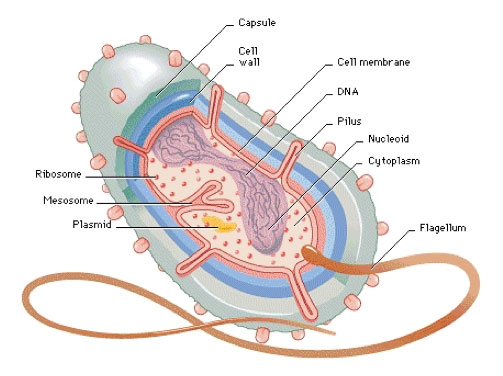Jul 30, 2022Vagina. The vagina is a muscular canal (approximately 10 cm long) that serves as the entrance to the reproductive tract. It also serves as the exit from the uterus during menses and childbirth. The outer walls of the anterior and posterior vagina are formed into longitudinal columns, or ridges, and the superior portion of the vagina—called the fornix—meets the protruding uterine cervix.
ch 26- reproductive organs, digestive, endocrine Flashcards | Quizlet
AboutTranscript. Humans reproduce and bear offspring through the reproductive system, which includes pregnancy, fetal development, and birth. Males have testes that produce sperm and a penis for delivery. Females have ovaries that produce eggs, a uterus for baby development, and breasts for milk production. Hormones regulate these organs.

Source Image: numerade.com
Download Image
Unique for its role in human reproduction, a gamete is a specialized sex cell carrying 23 chromosomes—one half the number in body cells. At fertilization, the chromosomes in one male gamete, called a sperm (or spermatozoon), combine with the chromosomes in one female gamete, called an oocyte. The function of the male reproductive system (Figure 27.2) is to produce sperm and transfer them to

Source Image: dhsprogram.com
Download Image
09.20 Antibiotic Evasion: The Biology of Avoidance
Male reproductive gland that produces sperm and male hormones. Ovaries. Female reproductive gland that produces eggs and female hormones. Menstrual cycle. Pattern of events in females involving the development and release of an egg. Fertilization. The process in sexual reproduction in which a male gamete and female gamete fuse to form a new cell.

Source Image: brainly.com
Download Image
What Part Of The Reproductive System Is Highlighted Below
Male reproductive gland that produces sperm and male hormones. Ovaries. Female reproductive gland that produces eggs and female hormones. Menstrual cycle. Pattern of events in females involving the development and release of an egg. Fertilization. The process in sexual reproduction in which a male gamete and female gamete fuse to form a new cell.
Learning Objectives. Describe the anatomy of the male and female reproductive systems, including their accessory structures. Explain the role of hypothalamic and pituitary hormones in male and female reproductive function. Trace the path of a sperm cell from its initial production through fertilization of an oocyte.
What part of the reproductive system is highlighted below? A. Vas deferens B. Urethra C. Seminal vesicles – brainly.com
Figure 27.9 Female Reproductive System The major organs of the female reproductive system are located inside the pelvic cavity. External Female Genitals The external female reproductive structures are referred to collectively as the vulva ( Figure 27.10 ). The mons pubis is a pad of fat that is located at the anterior, over the pubic bone.
A&P II Chapter 27 & 28 Lab Flashcards | Quizlet

Source Image: quizlet.com
Download Image
Reproductive Ch 25 Flashcards | Quizlet
Figure 27.9 Female Reproductive System The major organs of the female reproductive system are located inside the pelvic cavity. External Female Genitals The external female reproductive structures are referred to collectively as the vulva ( Figure 27.10 ). The mons pubis is a pad of fat that is located at the anterior, over the pubic bone.

Source Image: quizlet.com
Download Image
ch 26- reproductive organs, digestive, endocrine Flashcards | Quizlet
Jul 30, 2022Vagina. The vagina is a muscular canal (approximately 10 cm long) that serves as the entrance to the reproductive tract. It also serves as the exit from the uterus during menses and childbirth. The outer walls of the anterior and posterior vagina are formed into longitudinal columns, or ridges, and the superior portion of the vagina—called the fornix—meets the protruding uterine cervix.

Source Image: quizlet.com
Download Image
09.20 Antibiotic Evasion: The Biology of Avoidance
Unique for its role in human reproduction, a gamete is a specialized sex cell carrying 23 chromosomes—one half the number in body cells. At fertilization, the chromosomes in one male gamete, called a sperm (or spermatozoon), combine with the chromosomes in one female gamete, called an oocyte. The function of the male reproductive system (Figure 27.2) is to produce sperm and transfer them to

Source Image: whatayear.org
Download Image
Reproductive System Lab Flashcards | Quizlet
The primary function of the human reproductive system is to produce sex cells. When a male and female sex cell unite, an offspring grows and develops. The reproductive system is usually comprised of either male or female reproductive organs and structures. The growth and activity of these parts are regulated by hormones.

Source Image: quizlet.com
Download Image
Mucus Penetration of Surface-Engineered Nanoparticles in Various pH Microenvironments | ACS Nano
Male reproductive gland that produces sperm and male hormones. Ovaries. Female reproductive gland that produces eggs and female hormones. Menstrual cycle. Pattern of events in females involving the development and release of an egg. Fertilization. The process in sexual reproduction in which a male gamete and female gamete fuse to form a new cell.

Source Image: pubs.acs.org
Download Image
Evolution of cereal floral architecture and threshability: Trends in Plant Science
Learning Objectives. Describe the anatomy of the male and female reproductive systems, including their accessory structures. Explain the role of hypothalamic and pituitary hormones in male and female reproductive function. Trace the path of a sperm cell from its initial production through fertilization of an oocyte.

Source Image: cell.com
Download Image
Reproductive Ch 25 Flashcards | Quizlet
Evolution of cereal floral architecture and threshability: Trends in Plant Science
AboutTranscript. Humans reproduce and bear offspring through the reproductive system, which includes pregnancy, fetal development, and birth. Males have testes that produce sperm and a penis for delivery. Females have ovaries that produce eggs, a uterus for baby development, and breasts for milk production. Hormones regulate these organs.
09.20 Antibiotic Evasion: The Biology of Avoidance Mucus Penetration of Surface-Engineered Nanoparticles in Various pH Microenvironments | ACS Nano
The primary function of the human reproductive system is to produce sex cells. When a male and female sex cell unite, an offspring grows and develops. The reproductive system is usually comprised of either male or female reproductive organs and structures. The growth and activity of these parts are regulated by hormones.